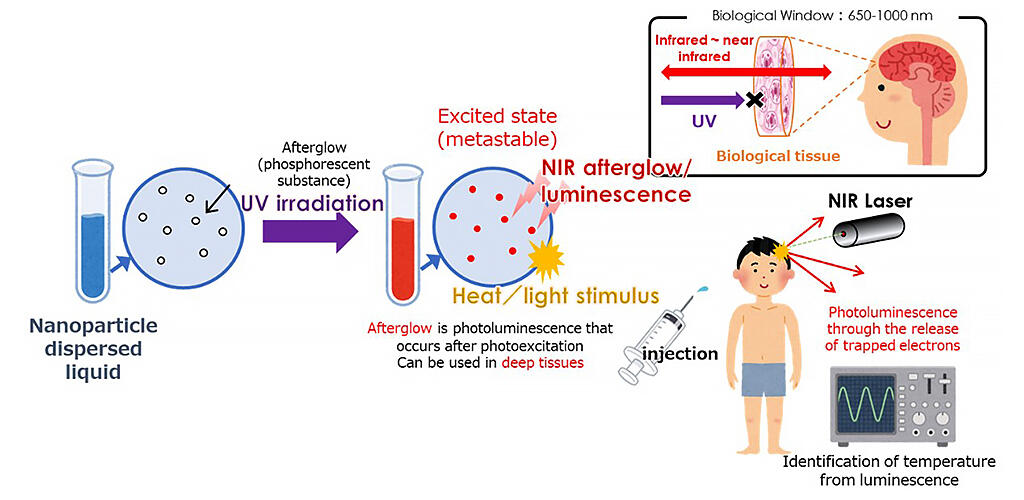Measuring body temperature is essential in clinical medicine, and the development of rapid and accurate methods for measuring deep body temperature is highly sought after in the medical and healthcare fields. However, current deep-body temperature monitoring is performed via catheter insertion, which is physically burdensome and limited in regard to measurement points. A research group consisting of graduate students Masaharu Ohashi (at the time of the research) and Aoni Sato (at the time of the research) of the Department of Applied Physics, Graduate School of Engineering at Tohoku University, Professor Takumi Fujiwara, Dr. Noriko Onoue (Chief of Cardiovascular Medicine) and Dr. Tsuyoshi Shinozaki (Vice President) of Sendai Medical Center, and Dr. Takamichi Miyazaki of the Technical Division, School of Engineering at Tohoku University, has successfully proposed and demonstrated a minimally invasive and highly accurate elemental technology for deep biological temperature sensing. Their findings were published in Scientific Reports and Ceramics International.

Provided by Tohoku University, with modifications
Afterglow is a phenomenon observed in photoluminescent objects that continue to emit light even in the dark. Light energy is temporarily stored by trapping the electrons excited by light irradiation at the trapping site, and the trapped electrons are gradually released thermally, resulting in luminescence.
Noting that the intensity of the afterglow decreases (attenuates) rapidly as the temperature of the afterglow increases, the research group proposed a new temperature sensing method to measure the temperature inside a living body by introducing a nano-sized afterglow into the body as a probe and detecting the afterglow from the outside, and have successfully demonstrated the principle of this measurement.
However, the measurement of afterglow attenuation at a particular time can be done only once, and the measurement takes several minutes, making time reduction and repetitive measurement a challenge for rapid and accurate temperature measurements. Zirconia (ZrO2), which has high biocompatibility, was used as a probe with afterglow properties, but its temperature sensing performance remained unknown.
In addition to afterglow, light can be extracted from the afterglow by a phenomenon called photoexcited luminescence. Trapped electrons are gradually released thermally and slowly emit an afterglow, but irradiation with near-infrared (NIR) light forces the release of light energy in a short period of time (photoexcited luminescence). The research group attempted repeated measurements using residual ZrO2 probes with a pulsed NIR laser.
In this study, they demonstrated that measurements can be repeated more than 100 times by enhancing the afterglow intensity by inducing photoexcited luminescence from a short pulse of NIR light.
In previous temperature measurements using afterglow attenuation, the time required for the luminescence intensity to decrease to one-tenth of the initial intensity at an ambient temperature of 40°C was about 600 seconds, but with the pulsed NIR irradiation conducted in this study, the time required was only a few seconds, and significantly shortening the measurement time and improvement of accuracy by repeating the pulsed NIR irradiation was found to be possible. The research group confirmed that the inverse of the obtained afterglow lifetime shows Arrhenius-type behavior with respect to the ambient temperature, and also demonstrated the feasibility of biological temperature measurements using pulsed NIR irradiation.
The wavelength range of 650 to 1000 nanometers (red to near-infrared region) is a region that has good optical transparency in biological tissues, and since the NIR laser is also in this wavelength range, position-selective and arbitrary-timing temperature measurements are possible with pulsed irradiation from outside the human body. Furthermore, while afterglow causes the release of trapped electrons from when the probe is introduced into a biological body, but it is not released near the temperature of the biological body because the release of photoexcited luminescence needs to be larger than the thermal energy of the temperature of the biological body. As a result, there is a significant advantage that measurement can be done at any time with NIR irradiation.
The group also evaluated the temperature measurement sensitivity of ZrO2 by examining the activation energy based on the thermoluminescence method. They found that the luminescent material is about one order of magnitude larger than existing luminescent materials for temperature measurement and has superior probing performance.
As such, there are expectations for using a coherent pulsed NIR laser as a light source for minimally invasive and highly accurate spatio-temporal temperature measurement of the temperature of biological bodies. In addition, the group demonstrated the potential for the application of ceramic ZrO2, which has been important for artificial joints and artificial bones, in new medical devices.
This article has been translated by JST with permission from The Science News Ltd.(https://sci-news.co.jp/). Unauthorized reproduction of the article and photographs is prohibited.




